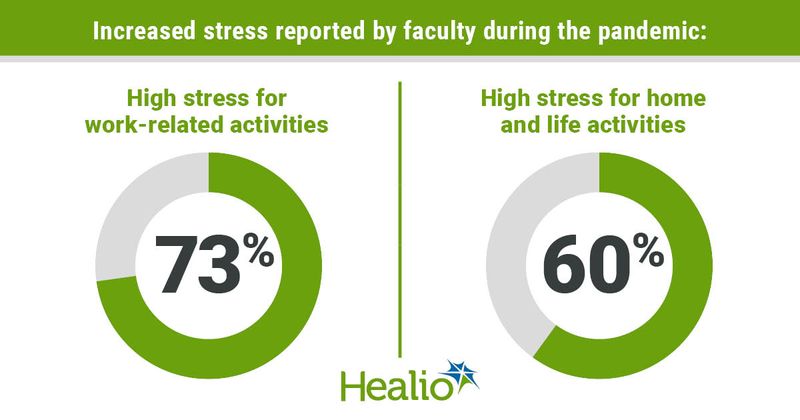Women, junior faculty report higher stress responses from the COVID-19 pandemic
Women and early- to mid-career physicians were more negatively impacted by increased workloads, stress and decreased self-care as a result of the COVID-19 pandemic, according to data published in Journal of Women’s Health.
“The coronavirus disease 2019 (COVID-19) pandemic has led to a significant and unprecedented disruption of all facets of our lives,” Pavitra Kotini-Shah, MD, director of resident ultrasound education and assistant professor of clinical emergency medicine at Chicago Medicine, and colleagues wrote. “Academic faculty were directly affected by the stay-at-home order, impacting research work, teaching and search responsibilities, thereby altering any balancing of work-life previously achieved.”

Respondent characteristics
To identify personal and professional characteristics of faculty that may have been affected by the pandemic, Kotini-Shah and colleagues sent a 93-question survey to faculty at a large urban public university and medical center.
Of the 497 respondents included in the study, most self-identified as women (60%), white (79%) and married/cohabitating (79%). More of the women were childless or had only one child in the household (59%) whereas men most often lived with two children (41%).
Most respondents reported increased stress levels during the pandemic, with 73% reporting high stress for work-related activities and 60% reporting high stress for home and life activities.
Women reported more stress than men related to scholarly productivity, teaching, advising and clinical responsibilities. Women also reported more stress related to child care, other dependent responsibilities and their personal health.
The researchers then classified respondents based on reported work and home stress, sex, faculty position (assistant or associate professor and tenure status) and having at least one child aged younger than 12 years. Age, marital status, type of academic degree, caring for elderly dependents, or having an essential worker as a household partner were not included among the variables because they did not yield significant results.
Class 1 (35%) reported high levels of work and home stress, and were more likely to be women, assistant professors and have a child aged 12 years or younger.
Class 2 (22%) reported high levels of work and home stress, were more likely to be women and associate professors and have a child aged 12 years or younger.
Class 3 (24%) reported moderate work stress but lower home stress, were tenured and less likely to have a child aged 12 years or younger.
Class 4 (19%) reported lower levels of work and home stress; were more likely to be men, an adjunct or visiting professor, and not tenured; and were less likely to have a child aged 12 years or younger.
Impact on productivity, self-care
Overall, researchers categorized the first two classes as being more likely to be women with young children and assistant/associate professors who had high work and home stress and changes in work-life balance.
“When the pandemic hit, we continued to meet and talk about personal struggles on the home front and at work, adjusting to schedules and clinical care,” Kotini-Shah said in a press release. “The juggling at home and work contributed to stress, but in the end it was the research and writing productivity, which had the least immediate external accountability, that suffered the most. That compounded with uncertainty and unprecedented personal risk ... were the factors that led to the creation of this survey hoping to hear what others also experienced.”
For example, those in Class 4 devoted less time to grants and advising during the pandemic than the other classes, whereas they devoted more time to clinical and teaching responsibilities compared with Classes 2 and 3. Those in Class 2 spent a significantly higher proportion of work time dedicated to committee and administrative responsibilities compared with Classes 1 and 4, with 54.7% of Class 2 also reporting a decrease in scholarly activity.
Time allocation and research productivity during the COVID-19 pandemic changed significantly among all respondents (P = .013).
Regarding self-care during COVID-19, researchers noted that the first two categories, defined by the highest home and works stress, also had the most significant change in work-life balance.
Specifically, most faculty in Class 1 (61.9%) and Class 2 (63.8%) reported sleep disturbance, whereas most in Class 3 (45.6%) and Class 4 (50%) reported no change in sleep. Similarly, more faculty in Class 1 (51.4%) and Class 2 (48.9%) reported disturbance in their diet compared with Class 3 (27.2%) and Class 4 (28.1%).
“We demonstrate the need for academic leaders to evaluate how their faculty were affected by the pandemic,” Kotini-Shah and colleagues wrote. “To effectively support their faculty, academic leaders need to acknowledge these differences and be inclusive of faculty with different experiences when adjusting workplace or promotion policies.”

